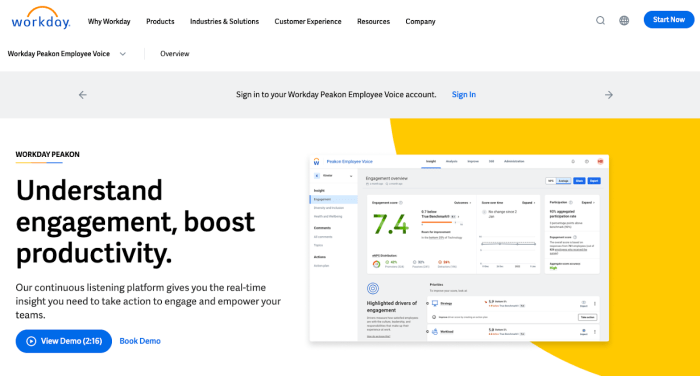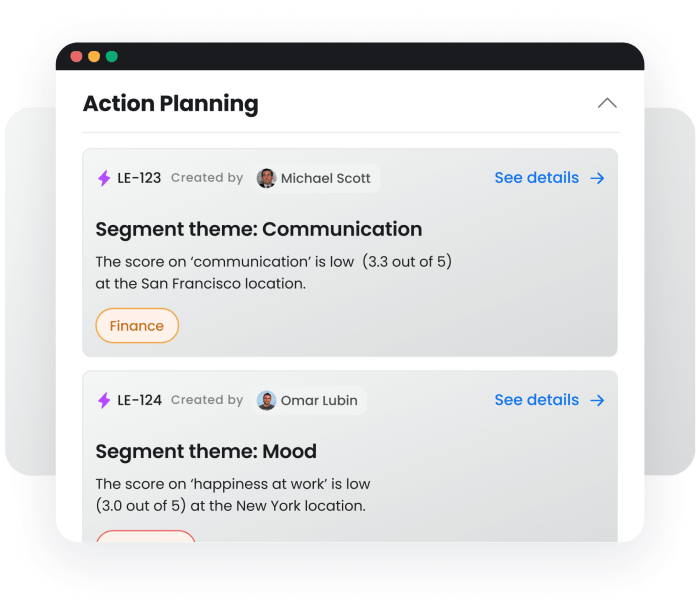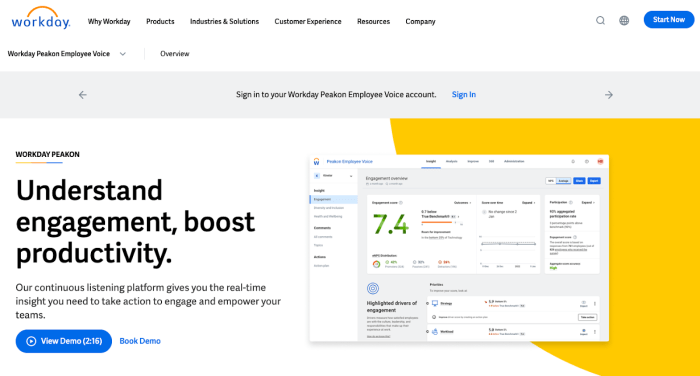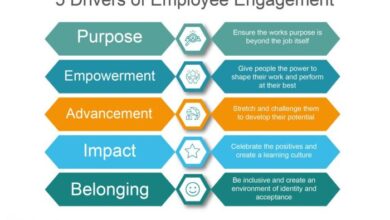
Employee engagement survey tools sets the stage for a deeper understanding of employee well-being and productivity within organizations. These tools provide valuable insights into employee satisfaction, morale, and their overall experience in the workplace. Different types of tools exist, from software platforms and apps to straightforward questionnaires, each offering various features and functionalities. This comprehensive guide explores the benefits, selection process, implementation, analysis, and continuous improvement strategies associated with employee engagement survey tools.
Understanding employee engagement is crucial for any organization aiming to boost productivity and foster a positive work environment. Survey tools allow for the collection of valuable feedback from employees, allowing employers to pinpoint areas needing improvement and tailor their approach for better results. Choosing the right tool is critical and depends on factors such as budget, HR system compatibility, and the specific needs of the organization.
Introduction to Employee Engagement Survey Tools
Employee engagement survey tools are powerful instruments for understanding and improving the workplace experience. They provide valuable insights into employee attitudes, motivations, and overall satisfaction. By identifying areas of strength and weakness, organizations can implement strategies to foster a more positive and productive work environment. This leads to increased employee morale, higher retention rates, and improved organizational performance.These tools help gather data on employee feelings, perceptions, and experiences related to their work, their managers, and the organization as a whole.
They go beyond basic satisfaction surveys to explore deeper aspects of employee engagement, allowing organizations to address the root causes of disengagement and foster a more positive and productive work environment.
Different Types of Employee Engagement Survey Tools
Employee engagement survey tools come in various forms, catering to different needs and budgets. Understanding the different types available helps organizations choose the most appropriate tool for their specific requirements.
- Software Platforms: These are comprehensive platforms that allow for the design, deployment, analysis, and reporting of employee engagement surveys. They often include features like customizable questionnaires, automated reminders, and sophisticated reporting dashboards. Examples include Qualtrics, SurveyMonkey, and Culture Amp.
- Mobile Apps: Mobile apps provide a convenient way for employees to complete surveys on their smartphones or tablets. They offer flexibility and accessibility, encouraging higher response rates, especially in organizations with a geographically dispersed workforce. Examples include SurveySparrow and Glint.
- Questionnaires: These are more basic tools often used for smaller surveys or quick pulse checks. They can be created and distributed manually, but they may lack the advanced analytics and reporting capabilities of software platforms. Examples include paper-based surveys or simple online forms.
Key Features and Functionalities
Employee engagement survey tools offer a range of features that contribute to their effectiveness. These features often include the ability to:
- Customize Survey Questions: The ability to tailor questions to specific organizational needs is crucial. This allows for gathering precise data that directly relates to the company’s objectives and values. For example, questions could focus on aspects of company culture, management style, or career development opportunities.
- Automated Reminders: Automated reminders improve survey response rates by prompting employees to complete the survey. This helps ensure a statistically significant sample size and reliable data.
- Data Analysis and Reporting: Comprehensive reporting tools provide insightful analysis of the collected data. Visualizations, such as graphs and charts, allow for easy interpretation and identification of trends and patterns in employee feedback. This feature aids in the identification of areas requiring improvement and highlights areas of strength within the organization.
Comparative Analysis of Employee Engagement Survey Tools
The table below provides a comparison of different employee engagement survey tools based on their type, key features, and pricing models. It’s important to note that pricing can vary significantly depending on the specific features and functionalities required.
| Tool Type | Key Features | Pricing |
|---|---|---|
| Software Platforms | Customizable questionnaires, automated reminders, sophisticated reporting dashboards, advanced analytics | Typically tiered pricing models based on user count, survey volume, and feature access |
| Mobile Apps | Easy access for employees on mobile devices, real-time data collection, push notifications | Usually subscription-based pricing, with varying options for different user levels |
| Questionnaires | Basic survey creation and distribution, simple data analysis | Pricing often depends on the number of surveys or responses required |
Benefits of Using Employee Engagement Survey Tools
Implementing employee engagement survey tools offers significant advantages for organizations seeking to foster a thriving and productive workforce. These tools provide a structured and systematic approach to understanding employee sentiment, enabling organizations to identify areas for improvement and implement targeted strategies for enhancing engagement. By gathering valuable insights, companies can build a more positive work environment, boost employee morale, and ultimately drive greater productivity.Employee engagement survey tools are more than just a box-checking exercise; they are a powerful diagnostic tool that helps organizations understand their workforce’s needs and aspirations.
This deeper understanding can lead to more effective management strategies and improved overall organizational performance. Ultimately, these tools empower organizations to create a work environment that values employees and encourages their active participation in the company’s success.
Impact on Employee Morale and Productivity
Employee engagement directly correlates with higher levels of job satisfaction and motivation. Surveys can uncover factors contributing to low morale, such as unclear expectations, inadequate resources, or a lack of recognition. Addressing these issues through targeted interventions can significantly improve employee morale. When employees feel valued and engaged, their productivity naturally increases. Studies have shown a strong positive relationship between employee engagement and productivity.
For example, organizations with highly engaged employees often report higher profitability and lower employee turnover rates.
Improving Communication and Collaboration
Employee engagement surveys can illuminate communication gaps and areas where collaboration could be strengthened. By identifying communication breakdowns, companies can implement strategies to improve clarity and transparency in communication channels. Improved communication fosters a sense of shared purpose and encourages employees to collaborate effectively towards common goals. Tools can also identify areas where collaboration platforms or processes could be enhanced, creating a more cohesive and supportive work environment.
Comparison of Different Survey Tools
Different employee engagement survey tools cater to various organizational needs and cultures. Some tools focus on specific aspects of engagement, such as recognition or work-life balance, while others provide a comprehensive view of the entire employee experience. Tools designed for a company with a highly collaborative culture may prioritize questions about teamwork and cross-functional communication, whereas tools for a more individualistic culture might focus on personal growth opportunities and career development.
Careful consideration of the organizational culture and specific objectives is crucial when selecting a tool.
Measuring and Tracking Engagement Metrics
A comprehensive engagement survey tool should offer a range of metrics to assess employee engagement. These metrics can encompass various aspects of the employee experience, including satisfaction with compensation, management, work-life balance, and opportunities for growth. A well-designed tool will provide detailed reporting and visualization capabilities, allowing organizations to track progress over time and identify trends in employee engagement.
| Survey Tool | Engagement Metric 1 (e.g., Satisfaction with Compensation) | Engagement Metric 2 (e.g., Opportunities for Growth) | Engagement Metric 3 (e.g., Communication Effectiveness) |
|---|---|---|---|
| Tool A | Employee ratings on salary fairness, compensation structure | Number of training opportunities, leadership development programs | Frequency of company-wide communication, feedback mechanisms |
| Tool B | Employee satisfaction scores on salary and benefits packages | Opportunities for skill enhancement, career advancement pathways | Employee perception of communication clarity, channels for feedback |
| Tool C | Employee responses on perceived value of compensation | Opportunities for professional growth, skill development | Frequency of internal communication, ease of access to information |
Choosing the Right Employee Engagement Survey Tool

Selecting the perfect employee engagement survey tool is crucial for gaining valuable insights into employee sentiment and driving positive change within an organization. A well-chosen tool can provide actionable data that empowers managers to address concerns and foster a more engaged workforce. However, the market offers a plethora of options, each with unique features and capabilities. Careful consideration of specific needs and resources is essential to ensure the chosen tool aligns with organizational goals and provides a positive return on investment.
Factors to Consider When Selecting a Tool
Several key factors influence the effectiveness and suitability of an employee engagement survey tool. These include understanding the organization’s specific needs, the tool’s compatibility with existing HR systems, budgetary constraints, and the tool’s ease of use and reporting capabilities. By carefully evaluating these elements, organizations can choose a tool that delivers meaningful results and drives meaningful change.
- Organizational Needs: Clearly define the specific objectives of the survey. Are you looking to measure overall engagement, identify areas for improvement in specific departments, or understand employee satisfaction with certain company policies? Understanding the precise goals will help narrow down the choices and ensure the tool provides relevant data.
- HR System Compatibility: Ensure the chosen tool seamlessly integrates with existing HR systems. This streamlines data import and export, eliminating manual data entry and potential errors. Compatibility with existing platforms like payroll, performance management, and employee self-service portals is critical for efficient data management and reporting.
- Budget Constraints: Survey tools vary significantly in pricing. Evaluate the cost of the tool against the anticipated value it will bring. Consider factors such as licensing fees, ongoing support, and potential customization options. Balancing the cost with the expected return on investment is vital for long-term success.
Ease of Use and Customization
The user-friendliness of the survey platform is paramount. A tool that is intuitive and easy to navigate will encourage higher participation rates and ensure accurate data collection. The platform should be easily accessible to both survey administrators and respondents. Customization options are also essential, allowing the tool to adapt to the organization’s unique needs and branding. The flexibility to adjust question wording, design elements, and reporting formats is crucial.
Employee engagement survey tools are crucial for understanding your team’s satisfaction levels. Recently, the Google EU Reach meeting of the minds ( google eu reach meeting of the minds ) highlighted the importance of fostering a positive work environment, which directly ties into the effectiveness of these tools. Ultimately, strong survey tools can help identify areas for improvement and drive a more engaged and productive workforce.
- Ease of Use: Consider the platform’s user interface and the ease with which both administrators and respondents can navigate the survey process. Intuitive design and clear instructions are key to a positive user experience. A user-friendly interface will increase participation rates and ensure that the survey is completed accurately.
- Customization Options: Evaluate the level of customization available to adapt the survey to the organization’s specific needs. This includes the ability to modify question wording, design elements, and reporting formats. Tailored surveys yield more accurate and relevant results, allowing for more focused and meaningful improvements.
Reporting Features
Comprehensive reporting capabilities are essential for extracting actionable insights from the survey data. The tool should provide various reporting options, such as graphical representations of results, key performance indicators (KPIs), and segment-specific analysis. This allows organizations to identify trends, patterns, and areas needing improvement. Effective reporting helps facilitate data-driven decision-making and ensures the survey’s value extends beyond the initial results.
- Reporting Options: The tool should provide a variety of reporting options, including graphical representations of results, segment-specific analysis, and detailed summaries. The ability to drill down into specific areas and identify patterns is critical for generating actionable insights. The tool should enable comparisons across different departments, teams, or employee demographics.
- Data Visualization: The tool should present data in an easy-to-understand format, such as charts, graphs, and tables. Visual representations of the results enhance comprehension and facilitate the identification of key trends and insights. Clear and concise visualizations allow for rapid analysis and decision-making.
Comparison of Survey Tools
A comparative analysis of different employee engagement survey tools can help organizations make informed decisions. Key factors to consider include ease of use, customization options, and reporting features. A table below provides a general overview of popular tools, highlighting their strengths and weaknesses. Remember to consider specific needs and budgetary constraints when evaluating these tools.
| Tool | Ease of Use | Customization | Reporting |
|---|---|---|---|
| Tool A | High | Moderate | Comprehensive |
| Tool B | Medium | High | Basic |
| Tool C | Low | Low | Limited |
Decision-Making Flowchart
A clear flowchart outlining the decision-making process for selecting the appropriate employee engagement survey tool can streamline the selection process. The flowchart should incorporate factors like budget, existing HR systems, desired reporting features, and ease of use. This visual representation provides a structured approach for evaluating potential tools and making an informed decision.
Employee engagement survey tools are crucial for understanding your workforce’s satisfaction levels. While things like trend micro handles VM security sans agents focus on different aspects of company operations, they both highlight the importance of smooth and efficient systems. Ultimately, the goal for any business is happy employees who feel valued, and these tools can be a great starting point for achieving that.
Implementing Employee Engagement Survey Tools
Successfully implementing an employee engagement survey tool is crucial for gaining valuable insights and driving positive change within your organization. A well-executed implementation process ensures that the survey accurately reflects employee sentiment and fosters a culture of open communication and feedback. This process should be meticulously planned and executed to maximize the impact of the survey results.Implementing an employee engagement survey tool involves a series of strategic steps that must be carefully considered to ensure its effectiveness.
From survey design and distribution to data analysis and action planning, each stage plays a critical role in maximizing the value derived from the survey. This comprehensive approach is essential for achieving a return on investment from the tool and fostering a more engaged workforce.
Designing an Effective Survey
Crafting a survey that effectively captures employee feedback requires careful consideration of various factors. A well-structured survey will elicit honest and meaningful responses, allowing for actionable insights. The questions should be clear, concise, and avoid ambiguity. Open-ended questions are valuable for uncovering deeper insights and understanding the “why” behind employee responses.
- Clearly define survey objectives: Establish specific goals for the survey. This ensures that the questions are aligned with the desired outcomes. For example, are you looking to identify areas of improvement in communication, or to gauge employee satisfaction with company benefits? Precisely defining the objectives will guide the survey design.
- Develop clear and concise questions: Ensure that every question is unambiguous and avoids double meanings. Use a mix of closed-ended (multiple choice) and open-ended questions. Closed-ended questions help in quantifying responses, while open-ended questions offer rich qualitative data.
- Pilot test the survey: Conduct a pilot test with a small group of employees before launching the survey to the wider workforce. This step helps identify any ambiguities or areas for improvement in question wording or format. Collecting feedback from this small group ensures the survey accurately captures the intended information.
- Maintain a positive tone: Phrase questions in a way that encourages honest and constructive feedback. Avoid loaded or leading questions that could bias the results. For instance, instead of asking “Are you satisfied with your manager?”, consider a more neutral question such as “How would you rate your manager’s communication style?”
Distributing and Encouraging Participation
Effective distribution strategies and participation incentives are essential for maximizing response rates and data collection. Communication is key to ensuring employees understand the importance of the survey and how their feedback will be used.
- Communicate the survey’s purpose: Inform employees about the survey’s objectives and how their feedback will contribute to improving the work environment. Explain how their responses will be used to drive positive change.
- Provide clear instructions: Offer clear and concise instructions on how to complete the survey. Include details about the time commitment required and the expected confidentiality of their responses.
- Incentivize participation: Consider offering incentives to encourage higher response rates. This could include raffle draws, gift cards, or even recognition for participation.
- Set a realistic timeframe: Establish a clear timeframe for completing the survey to maintain momentum and avoid survey fatigue.
- Ensure accessibility: Consider different methods of survey access, such as mobile-friendly options or multiple languages, to ensure participation from all employees, regardless of their location or circumstances.
Improving Response Rates and Data Collection
Strategies to improve response rates and data collection are critical for ensuring the survey’s validity and reliability. Implementing these strategies can help generate a comprehensive and insightful data set for your analysis.
Employee engagement survey tools are crucial for understanding employee sentiment and driving improvements. Recent advancements, like the potential of Wolfram Alpha to get brainier, as detailed in this insightful piece ( wolfram alpha to get brainier ), could revolutionize how these tools analyze and interpret data, leading to more effective strategies for boosting employee morale and productivity.
Ultimately, these sophisticated tools will help companies better understand and respond to their workforce needs.
- Follow-up with non-respondents: Send reminders to employees who have not yet completed the survey. These reminders can help nudge participation and encourage those who might have overlooked the survey.
- Provide regular updates: Inform employees about the progress of data analysis and the potential use of survey results in improving workplace practices. This ongoing transparency can enhance trust and engagement.
- Use multiple distribution channels: Employ various channels to distribute the survey, such as email, company intranet, or even through employee portals, ensuring maximum reach and visibility.
Analyzing and Interpreting Survey Results
Unveiling the insights hidden within employee feedback is crucial for fostering a thriving work environment. Analyzing survey results allows organizations to understand employee perspectives, identify areas needing improvement, and implement targeted strategies to enhance engagement and productivity. A well-executed analysis transforms raw data into actionable knowledge, guiding decisions that directly impact employee satisfaction and overall organizational success.
Importance of Analyzing Survey Results, Employee engagement survey tools
Understanding employee feedback is paramount for making informed decisions. Analysis of survey results provides a comprehensive understanding of employee sentiments, concerns, and suggestions. This deep dive into employee perspectives reveals crucial insights about the work environment, company culture, and management practices. Without proper analysis, valuable feedback remains untapped potential, hindering the identification of critical areas for improvement.
Identifying Key Trends and Patterns
Careful scrutiny of employee responses reveals underlying trends and patterns. Employing various analytical methods, such as grouping responses by department, job role, or tenure, helps to pinpoint recurring themes and potential correlations. For example, a consistent pattern of negative feedback regarding communication channels suggests a need for improvements in internal communication strategies. Analyzing responses through various lenses provides a holistic understanding of employee concerns and motivations.
Using Data Visualization Techniques
Effective data visualization transforms complex data into easily understandable and engaging visuals. Charts, graphs, and other visual representations effectively communicate key findings to stakeholders. For example, a bar graph displaying employee satisfaction levels across different departments allows for quick identification of disparities and areas demanding attention. These visual aids make complex data accessible and impactful, fostering a shared understanding of the survey results.
Creating Actionable Strategies
The analysis of survey results should lead to the development of clear and actionable strategies. By identifying patterns and trends, organizations can pinpoint areas needing improvement. For instance, if a significant number of employees express concerns about work-life balance, the organization can implement flexible work arrangements or explore opportunities for improved time management training. This data-driven approach ensures that interventions directly address identified issues and lead to positive outcomes.
Summary of Common Themes and Solutions
| Common Themes | Corresponding Solutions |
|---|---|
| Lack of communication | Implement regular team meetings, introduce an internal communication platform, and ensure transparency in decision-making processes. |
| Insufficient training opportunities | Provide comprehensive training programs tailored to specific roles and skill gaps. |
| Poor work-life balance | Offer flexible work arrangements, encourage time management strategies, and promote employee well-being initiatives. |
| Lack of recognition and appreciation | Implement regular employee recognition programs, public acknowledgements of accomplishments, and celebrate milestones. |
| Inadequate resources | Assess resource requirements and allocate necessary resources to support employee needs and operational efficiency. |
Enhancing Employee Engagement Through Actionable Strategies

Turning survey results into tangible improvements in employee engagement requires a proactive approach. Simply collecting data isn’t enough; the key lies in using those insights to drive meaningful change. This involves careful analysis, creative strategy development, and meticulous implementation. A well-defined action plan, rooted in the survey’s findings, is crucial for achieving lasting positive impact.Effective strategies for enhancing employee engagement are multifaceted and context-dependent.
Understanding the specific needs and desires of your workforce is paramount. This often involves a blend of improvements in workplace culture, compensation, and opportunities for professional growth.
Developing Improvement Strategies Based on Survey Results
Survey results provide a roadmap for identifying areas needing attention. Analyzing trends and patterns reveals recurring themes and concerns, offering valuable insights into the root causes of employee disengagement. Prioritizing these issues based on their impact and frequency is critical for focused improvement efforts.
Examples of Effective Engagement Strategies
Implementing effective strategies hinges on a deep understanding of employee needs and preferences. A few proven methods include:
- Improved Communication Channels: Establishing clear and consistent communication channels, such as regular town halls or team meetings, fosters a sense of transparency and connection. This ensures employees feel heard and valued, leading to greater engagement.
- Flexible Work Arrangements: Offering flexible work options, such as remote work or flexible hours, demonstrates trust and acknowledges the importance of work-life balance. This can significantly increase employee satisfaction and productivity.
- Mentorship and Skill Development Programs: Providing opportunities for skill development and mentorship programs not only enhances employee capabilities but also fosters a sense of growth and belonging within the organization. This demonstrates a commitment to employee career advancement, which boosts engagement.
- Recognition and Rewards Programs: Implementing recognition and reward systems that acknowledge and appreciate employee contributions fosters a positive work environment. Recognizing achievements, both big and small, can motivate and incentivize employees, contributing to their overall engagement.
Creating an Action Plan Based on Survey Insights
An action plan, derived from survey insights, should be specific, measurable, achievable, relevant, and time-bound (SMART). It should clearly Artikel the strategies to be implemented, the responsible parties, the timelines for completion, and the metrics to track progress. This structured approach ensures accountability and keeps the focus on achieving concrete results.
“A well-defined action plan is the cornerstone of any successful employee engagement initiative.”
Case Studies of Successful Implementations
The following table illustrates how various organizations have successfully implemented engagement strategies, leading to measurable improvements:
| Organization | Strategy Implemented | Results |
|---|---|---|
| TechCo | Implemented a mentorship program for junior engineers and introduced flexible work hours. | Increased employee satisfaction by 15% and reduced employee turnover by 10%. |
| Creative Solutions | Improved communication channels by establishing weekly team meetings and a company intranet. | Improved employee morale by 20% and increased collaboration across teams by 15%. |
| Healthcare Solutions | Developed a comprehensive training program and offered additional professional development opportunities. | Increased employee retention rate by 8% and boosted employee confidence in their professional development. |
Continuous Improvement and Monitoring
Staying engaged isn’t a one-time event; it’s a continuous journey. Monitoring employee engagement over time is crucial for understanding trends and adapting strategies. Regular assessments provide valuable insights into the effectiveness of your initiatives and allow for proactive adjustments to maintain a healthy and productive work environment.Employee engagement, like any other metric, needs consistent tracking to gauge effectiveness.
This allows for early identification of emerging issues and facilitates timely interventions. Proactive adjustments based on data-driven insights, instead of reactive measures, ultimately lead to more impactful and sustainable results.
Monitoring Employee Engagement Levels Over Time
Regular surveys are the cornerstone of continuous monitoring. Consistent data collection allows you to identify trends and patterns in employee sentiment. This can reveal areas of strength and weakness in your engagement strategies, allowing you to target interventions effectively. Key to this process is establishing a clear baseline and tracking progress from there.
Tracking Progress Against Established Goals and Targets
Establishing measurable goals is paramount. For example, a company aiming to increase employee satisfaction might set a target of a 15% improvement in survey scores within a year. Tracking progress against these goals is essential. Using visual aids, like charts and graphs, to illustrate the progress (or lack thereof) can provide a clear picture of how your engagement initiatives are performing.
This data-driven approach ensures that interventions are focused on achieving tangible results.
Adapting Strategies Based on Evolving Employee Needs
Employee needs and expectations evolve over time. Economic shifts, technological advancements, and changes in company culture all influence employee sentiment. Staying attuned to these shifts is critical. Monitoring engagement levels enables you to identify and address emerging issues proactively, ensuring that your initiatives remain relevant and effective. This adaptability is key to fostering a thriving and responsive work environment.
Best Practices for Continuous Improvement in Employee Engagement Programs
A robust continuous improvement plan hinges on a few key best practices. Regularly review survey results to identify areas for improvement. Use feedback to tailor interventions and strategies to address specific concerns. Actively solicit feedback from employees on the effectiveness of engagement initiatives. This ensures that your programs remain aligned with employee needs and expectations.
A Method for Scheduling Regular Surveys to Monitor Progress
A well-structured schedule is crucial for consistent data collection. A recommended approach involves conducting pulse surveys quarterly, or bi-annually, to track the evolution of employee engagement levels. These short surveys can capture quick snapshots of sentiment, providing a real-time pulse on how employees feel about their work environment. This frequency allows for timely intervention and adjustments to initiatives, ensuring engagement remains a priority.
For example, scheduling a survey for the last week of each quarter ensures a consistent data collection point.
Conclusion
In conclusion, implementing employee engagement survey tools is a powerful step toward building a more engaged and productive workforce. This guide has provided a thorough overview of the process, from choosing the right tool to analyzing results and implementing actionable strategies. By consistently monitoring and adapting to evolving employee needs, organizations can create a thriving work environment that fosters employee well-being and organizational success.






